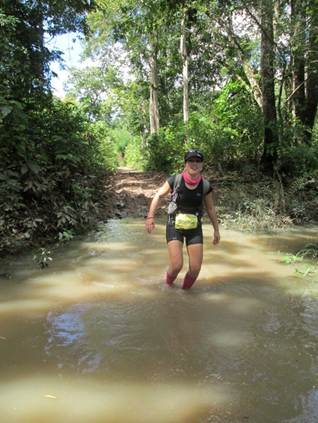Sophie Power: Ultrarunner’s Near-Death Experience Sparks Call for Individualised Hydration Strategies

Having recently broken the 48-hour treadmill world record in bid to inspire women in sport, British ultrarunner Sophie Power, from Guildford in Surrey, has opened up about a near death experience and the importance for female endurance athletes, both amateur and professional, to research, plan and execute a robust hydration strategy.
Her story began with a near-fatal incident in November 2012 during the 235k Ancient Khmer Path in Cambodia, where an insufficient understanding and inaccurate advice around her hydration nearly claimed her life.
image001.jpg
Sophie Power in Cambodia
Since then, she has not only broken multiple records but also represented Great Britain at the European and World Championships in 2022 and 2023, using her experiences to ensure that female athletes receive the correct advice to perform safely and at their best.
While competing in the 235k Ancient Khmer Path ultra, she was advised to drink up to six litres of water a day, which was excessive for her size. Following this misguided advice led to a dangerous drop in her sodium levels. This resulted in brain swelling and a subsequent coma. “I nearly lost my life,” she recalled, reflecting on the experience.
“I was encouraged to drink an entire bladder pack before I got to each aid station, but because I was leading the race, I didn’t have that long between each aid station. This was excessive for my size.
“I remember trying to finish the water, and it was hot and humid and combined with some very weak salt tablets which I wasn’t properly taking because I didn’t understand them, my sodium concentration went down to 108 when it is supposed to be 130.
“I collapsed into a coma and was airlifted by helicopter to intensive care,” she said.
Sophie had suffered from hyponatraemia, a potentially life-threatening condition characterised by low sodium levels in the blood, which can occur when drinking excessive amounts of water that dilutes, and even, flushes electrolytes from the body.
Since her near fatal experience, Sophie sought advice from some of the world’s leading experts in hydration and fuelling to better understand the concentration of sodium in her sweat to plan a personalised strategy for her.
Originally designed to help diagnose Cystic Fibrosis, Precision Fuel & Hydration have now used their patented Sweat Testing technology to help thousands of athletes to better understand their bodies and create an effective hydration (and fuelling) strategy that works for them.
Their data shows that some people lose as little as 200 milligrams of sodium per litre of sweat, whilst those at the top end of the scale can lose in excess of 2,000mg/l. The difference, and therefore the impact on your hydration strategy, can be huge.
Sophie explained: “I discovered I sweat almost 1000mg of sodium per litre of water, which is on the high side. This revelation allowed me to develop a much more personalised strategy that reflect my physiological needs.”
Since then, she has embraced a scientific approach to her training and racing; meticulously recording her hydration and fuelling strategies.
She also separates her liquid and food intake to maintain better control over her hydration levels which she says is crucial for the duration of her events because imbalances can occur rapidly.
“A comprehensive approach has significantly enhanced my endurance and recovery, so I can perform better over long distances,” she added. “I know what a dangerous situation getting it wrong can be, so for me it’s very much a case of using excel spreadsheets to keep on track.
Andy Blow, co-founder of Precision Fuel & Hydration (PF&H) and a leading expert in hydration, added; “Mild cases of hyponatraemia can undermine an athlete’s performance, yet in severe instances it can lead to life-threatening consequences.
“In Sophie’s case she is losing around 1000 milligrams of sodium per hour. Simply drinking plain water during prolonged periods of sweating would, at best, result in a loss in performance and could even potentially be dangerous.
“This just goes to show the importance of knowing your numbers – not only to allow you as an athlete to realise your potential but also stay healthy and safe whilst training or competing.”
So now comes the big question about gender. Do men and women sweat differently?
Some studies have shown that women may be at a greater risk of exercise-induced hyponatremia. Several different analyses of the data have reported incidences of hyponatremia being greater in women than men.
But this risk has been attributed to their lower body weight and size, as well as longer racing times relative to men, rather than their sex and different physiological responses.
A study conducted on participants at the 2002 Boston Marathon emphasised this point. It found 13% of finishers were hyponatraemic and the majority of those were women. The apparent sex difference disappeared when the data was adjusted for body mass index and racing times though.
Research has also highlighted that there may be subtle changes in fluid and sodium balance across a women’s menstrual cycle.
For Sophie, more needs to be done in sport to specifically focus on women, with only 6% of research in sport science and medicine conducted in 2020 focused exclusively on females, an argument which has already gained traction in the sporting community.
She said: “Only a small percentage of sports studies focus on female bodies, and I believe changing this is crucial to understand the unique physiological differences faced by women in endurance sport and encourage more women to participate in sport.”
However, Andy Blow emphasises that, when it comes to fuelling and hydration, generalisations around gender can obscure the unique needs of each athlete. He insists that any guidelines should be seen as genderless and tailored to the individual, ensuring that every athlete receives the personalised advice necessary for them.
He added: “A hydration strategy must be considered on an individual basis accounting for a person’s size, sweat rate, sweat composition, intensity and duration of the activity, and their environment. That is much more importance than their sex.
“There needs to be a shift in focus towards individual requirements rather than a one-size-fits-all approach based on gender, ensuring that every athlete receives the personalised advice necessary to optimise their performance and well-being.
Since her life-changing incident, Sophie Power has emerged as a two-time world record holder, becoming the fastest woman to run the length of Ireland and proudly representing Great Britain at the IAU 24-Hour World Championships.
Yet, her mission extends far beyond personal achievement. Power is dedicated to raising awareness about the critical need for accurate advice for female athletes. She is also committed to getting more women on start lines, founding SheRACES, a non-profit which works with events to make them more inclusive of female athletes
When asked about her about advice for women looking to get in to sport, she said:
Sign Up: The most crucial step is to register for an event. Many women doubt their abilities, but all are capable of facing challenging obstacles.
Find the Right Environment: Look for events designed with women in mind, as they foster a more supportive atmosphere. For example, women interested in endurance sports should seek events like the SheRACES 25 and 50km womens’ trail events, or other races accredited by SheRACES , which prioritise inclusivity and provide a welcoming environment.
Fuel and Hydrate: Practice fuelling strategies during training to determine what works best for each individual.
As Power continues to inspire others, she remains committed to ensuring women athletes have access to the accurate information and support they need to excel in their pursuits.



